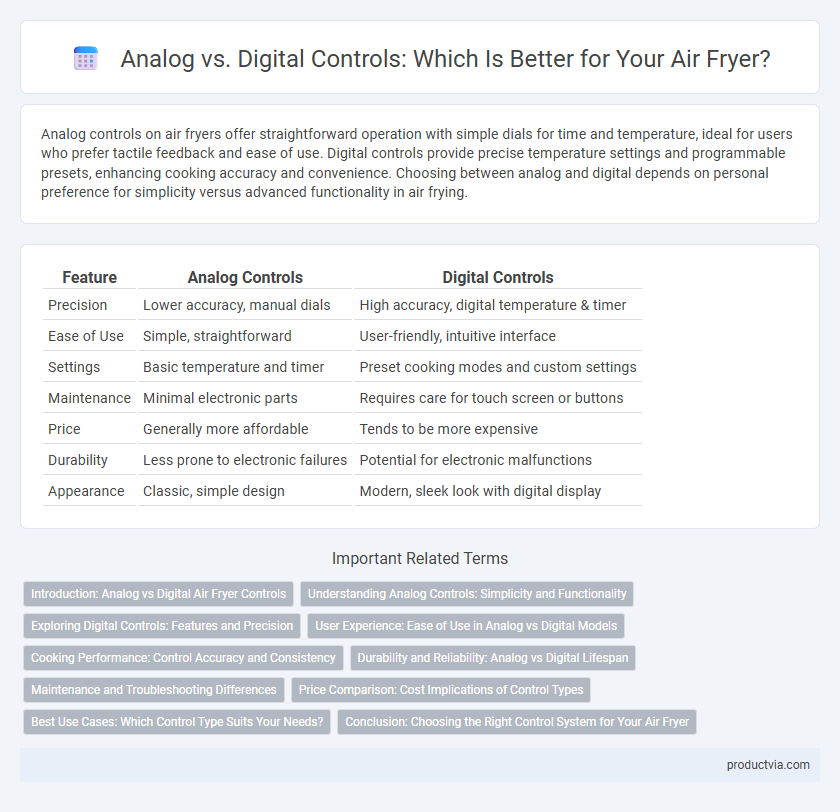Analog controls on air fryers offer straightforward operation with simple dials for time and temperature, ideal for users who prefer tactile feedback and ease of use. Digital controls provide precise temperature settings and programmable presets, enhancing cooking accuracy and convenience. Choosing between analog and digital depends on personal preference for simplicity versus advanced functionality in air frying.
Table of Comparison
| Feature | Analog Controls | Digital Controls |
|---|---|---|
| Precision | Lower accuracy, manual dials | High accuracy, digital temperature & timer |
| Ease of Use | Simple, straightforward | User-friendly, intuitive interface |
| Settings | Basic temperature and timer | Preset cooking modes and custom settings |
| Maintenance | Minimal electronic parts | Requires care for touch screen or buttons |
| Price | Generally more affordable | Tends to be more expensive |
| Durability | Less prone to electronic failures | Potential for electronic malfunctions |
| Appearance | Classic, simple design | Modern, sleek look with digital display |
Introduction: Analog vs Digital Air Fryer Controls
Analog air fryer controls provide simplicity with manual dials for temperature and time settings, appealing to users who prefer straightforward operation without advanced features. Digital air fryer controls offer precise temperature regulation and programmable presets, enhancing cooking accuracy and ease of use. Choosing between analog and digital depends on individual preferences for control granularity and technological functionality.
Understanding Analog Controls: Simplicity and Functionality
Analog controls in air fryers offer simplicity and straightforward functionality through mechanical dials for temperature and timer settings. These controls provide tactile feedback and ease of use, making them ideal for users who prefer intuitive operation without complex programming. Despite lacking advanced features seen in digital models, analog controls ensure reliable performance and quick adjustments during cooking.
Exploring Digital Controls: Features and Precision
Digital controls in air fryers offer precise temperature settings and customizable cooking times, enhancing overall cooking accuracy compared to analog dials. Features such as LED displays, pre-programmed cooking modes, and touch-sensitive panels provide users with intuitive operation and repeatable results. These advanced digital interfaces also often support smart functions like delayed starts and automatic shutoff, contributing to convenience and safety.
User Experience: Ease of Use in Analog vs Digital Models
Analog air fryer controls offer straightforward dials and knobs that allow users to quickly adjust temperature and time settings without navigating complex menus, making them ideal for beginners or those who prefer simplicity. Digital air fryer controls provide precise temperature and time adjustments with programmable settings and clear LED displays, enhancing accuracy and customization for tech-savvy users. User experience in analog models leans towards ease and speed, while digital models prioritize advanced control and detailed feedback.
Cooking Performance: Control Accuracy and Consistency
Analog air fryer controls rely on manual dials, offering straightforward operation but limited precision in temperature and time settings, which can result in less consistent cooking outcomes. Digital controls provide exact temperature and timer adjustments through electronic interfaces, enhancing control accuracy and ensuring more uniform cooking performance. This precision in digital models helps maintain consistent heat distribution and timing, critical for optimal air fryer results.
Durability and Reliability: Analog vs Digital Lifespan
Analog air fryer controls typically offer greater durability and reliability due to simpler mechanical components that are less prone to electronic failures. Digital controls, while providing precise temperature and time settings, often have shorter lifespans because of their reliance on sensitive circuit boards and touchscreen interfaces. Users prioritizing long-term use and minimal maintenance tend to prefer analog models for their robust and enduring performance.
Maintenance and Troubleshooting Differences
Analog air fryer controls feature manual knobs that are simpler to maintain due to fewer electronic components prone to failure, allowing straightforward troubleshooting by checking physical dial functionality. Digital air fryers rely on electronic touchpads and LED displays, which can be more complex to repair and may require professional diagnostics when facing issues like unresponsive buttons or display errors. Maintenance for digital models often involves software resets and inspecting circuit boards, whereas analog models primarily need cleaning and verifying mechanical integrity.
Price Comparison: Cost Implications of Control Types
Analog air fryer controls typically cost less upfront, making them a budget-friendly choice for basic cooking needs. Digital controls, often found in higher-end models, come with a higher price tag due to advanced features like precise temperature settings and programmable timers. The cost difference reflects the added convenience and cooking accuracy provided by digital interfaces compared to the simplicity of analog dials.
Best Use Cases: Which Control Type Suits Your Needs?
Analog controls on air fryers provide straightforward temperature and timer adjustments, ideal for users who prefer simplicity and tactile feedback, making them perfect for casual cooking or those new to air frying. Digital controls offer precise temperature settings, programmable presets, and often include touchscreens, catering to tech-savvy users or those seeking advanced cooking customization and consistency. Selecting between analog and digital controls depends on user preference for ease-of-use versus precision and additional features in air fryer operation.
Conclusion: Choosing the Right Control System for Your Air Fryer
Analog controls offer simplicity and ease of use with manual dials, ideal for users who prefer straightforward operation without complex settings. Digital controls provide precise temperature and timer adjustments, often featuring presets and touchscreens for enhanced cooking accuracy and convenience. Selecting the right control system depends on personal preferences for usability, desired cooking precision, and budget considerations.
Analog vs Digital Controls for Air Fryers Infographic

 productvia.com
productvia.com